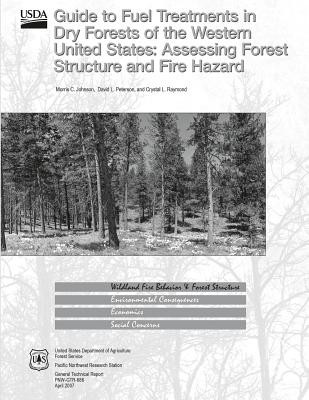
- We will send in 10–14 business days.
- Author: United States Department of Agriculture
- Publisher: CreateSpace Independent Publishing Platform
- Year: 2015
- Pages: 328
- ISBN-10: 1511544678
- ISBN-13: 9781511544672
- Format: 21.6 x 28 x 1.8 cm, softcover
- Language: English
- SAVE -10% with code: EXTRA
Guide to Fuel Treatments in Dry Forests of the Western United States (e-book) (used book) | bookbook.eu
Reviews
Description
Guide to Fuel Treatments analyzes a range of fuel treatments for representative dry forest stands in the Western United States with overstories dominated by ponderosa pine (Pinus ponderosa), Douglas-fir (Pseudotsuga menziesii), and pinyon pine (Pinus edulis). Six silvicultural options (no thinning; thinning from below to 50 trees per acre [tpa], 100 tpa, 200 tpa, and 300 tpa; and prescribed fire) are considered in combination with three surface fuel treatments (no treatment, pile and burn, and prescribed fire), resulting in a range of alternative treatments for each representative stand. The Fire and Fuels Extension of the Forest Vegetation Simulator (FFE-FVS) was used to calculate the immediate effects of treatments on surface fuels, fire hazard, potential fire behavior, and forest structure. The FFEFVS was also used to calculate a 50-year time series of treatment effects at 10-year increments. Usually, thinning to 50 to 100 tpa and an associated surface fuel treatment were shown to be necessary to alter potential fire behavior from crown fire to surface fire under severe fire weather conditions. This level of fuel treatment generally was predicted to maintain potential fire behavior as surface fire for 30 to 40 years, depending on how fast regeneration occurs in the understory, after which additional fuel treatment would be necessary to maintain surface fire behavior. Fuel treatment scenarios presented here can be used by resource managers to examine alternatives for National Environmental Policy Act documents and other applications that require scientifically based information to quantify the effects of modifying forest structure and surface fuels.
EXTRA 10 % discount with code: EXTRA
The promotion ends in 18d.13:46:18
The discount code is valid when purchasing from 10 €. Discounts do not stack.
- Author: United States Department of Agriculture
- Publisher: CreateSpace Independent Publishing Platform
- Year: 2015
- Pages: 328
- ISBN-10: 1511544678
- ISBN-13: 9781511544672
- Format: 21.6 x 28 x 1.8 cm, softcover
- Language: English English
Guide to Fuel Treatments analyzes a range of fuel treatments for representative dry forest stands in the Western United States with overstories dominated by ponderosa pine (Pinus ponderosa), Douglas-fir (Pseudotsuga menziesii), and pinyon pine (Pinus edulis). Six silvicultural options (no thinning; thinning from below to 50 trees per acre [tpa], 100 tpa, 200 tpa, and 300 tpa; and prescribed fire) are considered in combination with three surface fuel treatments (no treatment, pile and burn, and prescribed fire), resulting in a range of alternative treatments for each representative stand. The Fire and Fuels Extension of the Forest Vegetation Simulator (FFE-FVS) was used to calculate the immediate effects of treatments on surface fuels, fire hazard, potential fire behavior, and forest structure. The FFEFVS was also used to calculate a 50-year time series of treatment effects at 10-year increments. Usually, thinning to 50 to 100 tpa and an associated surface fuel treatment were shown to be necessary to alter potential fire behavior from crown fire to surface fire under severe fire weather conditions. This level of fuel treatment generally was predicted to maintain potential fire behavior as surface fire for 30 to 40 years, depending on how fast regeneration occurs in the understory, after which additional fuel treatment would be necessary to maintain surface fire behavior. Fuel treatment scenarios presented here can be used by resource managers to examine alternatives for National Environmental Policy Act documents and other applications that require scientifically based information to quantify the effects of modifying forest structure and surface fuels.


Reviews